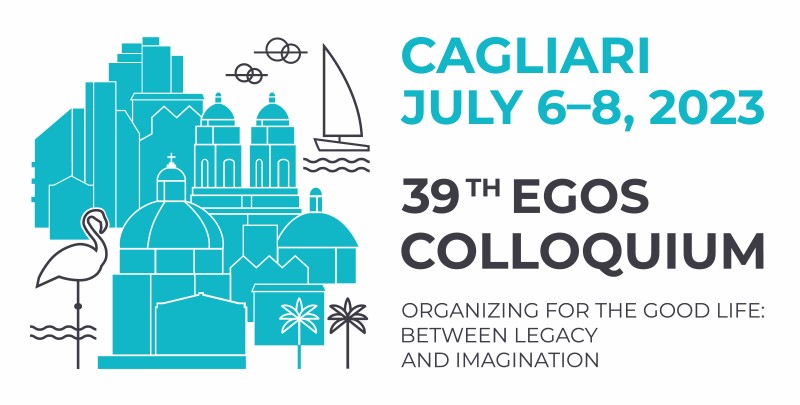Sub-theme 41: Imagination and Language: The Poetics of Entrepreneurial and Organizational Becoming [HYBRID] ---> MERGED with sub-theme 46
Call for Papers
The purpose of this sub-theme is to extend and integrate theories on imagination, poetic language and communication in
the literatures on organizational becoming and organizing for the future. Imagination is regarded as a central human faculty
(Rorty, 1989) and a cornerstone of entrepreneurial and organizational temporal dynamics (Beckert, 2021; Thompson & Byrne,
2022) as well as sensegiving and sensemaking (Weick, 1995). While it is the mental impetus for creating imaginaries, actors
must make their meanings publicly visible and actionable in order to bring others along: imagination and language are thus
inevitably intertwined. Imagination ushers a future, whereas language anchors us in the present. New vocabularies enable us
to formulate new purposes and thereby transcend current practices (Rorty, 1989).
Organizational becoming
offers a processual view of reality that is particularly relevant to studying organizational emergence and change. Recent
research in this area points to imagination and poetic language as central to various organizing processes. Imaginative creation
and “poetic power” (Shackle, 2010) embrace both transcendence and immanence, both mind and body, thereby making imagination
a combined conscious, unconscious, and spiritual act (Chiles et al., 2021). As the creative capacity to define and develop
new entrepreneurial opportunities is critical for shaping the future, imagination has gained even more importance in light
of pressing global challenges. It is routinely applied in (re)constructing past, interpreting present (Kaplan & Orlikowski,
2013), and envisioning possible futures (Thompson & Byrne, 2022). This enables actors to frame unfamiliar situations as
familiar and build coherence between past and present (Carlsen, 2006; Sergeeva et al., 2021).
Recent scholarship
at the intersection of imagination and language has explored how poetry and craft intertwine in efforts to materialize imagined
futures (Liubertė & Dimov, 2021). Language enables us to engage in sensemaking of our experiences and in sensegiving to
others (Cornelissen & Clarke, 2010) in order to communicate the desirability and plausibility of future worlds (Rindova
& Martins, 2021) and win the support of external actors (Roundy, 2020). In this vein, organizations are wrought into existence
through an oscillating dynamic: actions and artefacts stimulate the imagination, while imagination recursively stimulates
actions and artefact creation (Thompson, 2018). Thus, imaginations are like a set of dialogs that reinforce each other in
the process of organizational becoming (Carlsen, 2006) and help us make our ideas come into being (Dimov, 2020). Imagination
is also instrumental for making our language persuasive and memorable. In turn, we need language in order to communicate imagined
futures for which existing vocabularies are inadequate (Christensen et al., 2019), and we do this through various communicative
means – words, drawings, use of objects or bodily movements (Thompson, 2018).
We welcome contributions that
focus on the relationships of processes or practices of organizational becoming with imagination and poetic language, through
new conceptual, methodological and empirical means. Possible topics for submission include:
How do entrepreneurs, strategizers or other organizational actors use poetic language in their activities/organizing processes? How does poetic language (1) enable the construction of meaning of their imaginings; (2) drive sensemaking and sensegiving processes; (3) help to give voice to other beings (ventriloquize) or develop imagination?
What are the discursive and non-discursive processes and practices that make imaginings visible and actionable? How are these imaginings realised through social, cognitive, affective, bodily, material, spiritual phenomena, and various communicative means – words, drawings, use of objects, gestures or dance? How do our vocabularies and public discourses change due to our imaginings?
How do imagination and poetic language shape the processes of entrepreneurial design and articulation of value?
What roles do imagination and language play in light of global challenges? How do these roles manifest themselves in inclusivity-related issues? What are the moral and ethical dilemmas and concerns of using poetic language in shaping visions?
References
- Beckert, J. (2021): “The Firm as an Engine of Imagination: Organizational prospection and the making of economic futures.” Organization Theory, 2 (2), first published online on April 6, 2021, https://doi.org/10.1177/26317877211005773.
- Carlsen, A. (2006): “Organizational becoming as dialogic imagination of practice: The case of the indomitable Gauls.” Organization Science, 17 (1), 132–149.
- Chiles, T.H., Crawford, B., & Elias, S.R. (2021): “Mind, body, and soul: A spiritual perspective on the entrepreneurial imagination.” Organization Theory, 2 (2), first published online on May 11, 2021, https://doi.org/10.1177/26317877211005786.
- Christensen, L.T., Kärreman, D., & Rasche, A. (2019): “Bullshit and organization studies.” Organization Studies, 40 (10), 1587–1600.
- Cornelissen, J.P., & Clarke, J.S. (2010): “Imagining and Rationalizing Opportunities: Inductive Reasoning and the Creation and Justification of New Ventures.” Academy of Management Review, 35 (4), 539–557.
- Dimov, D. (2020): “Opportunities, language, and time.” Academy of Management Perspectives, 34 (3), 333–351.
- Kaplan, S., & Orlikowski, W.J. (2013): “Temporal work in strategy making.” Organization Science, 24 (4), 965–995.
- Liubertė, I. & Dimov, D. (2021): “‘One tiny drop changes everything’: Constructing opportunity with words.” Journal of Business Venturing Insights, 15, https://doi.org/https://doi.org/10.1016/j.jbvi.2021.e00242.
- Rindova, V.P., & Martins, L.L. (2021): “Futurescapes: Imagination and temporal reorganization in the design of strategic narratives.” Strategic Organization, 20 (1), 200–224.
- Rorty, R. (1989): Contingency, Irony, and Solidarity. Cambridge, UK: Cambridge University Press.
- Roundy, P.T. (2020): “On Entrepreneurial Stories: Tolkien’s Theory of Fantasy and the Bridge between Imagination and Innovation.” Business Perspectives and Research, 9 (1), 31–45.
- Sergeeva, A., Bhardwaj, A., & Dimov, D. (2021): “In the heat of the game: Analogical abduction in a pragmatist account of entrepreneurial reasoning.” Journal of Business Venturing, 36 (6), https://doi.org/10.1016/j.jbusvent.2021.106158.
- Shackle, G.L.S. (2010): The Nature of Economic Thought: Selected Papers 1955–1964. Cambridge, UK: Cambridge University Press.
- Thompson, N.A. (2018): “Imagination and creativity in organizations.” Organization Studies, 39 (2–3), 229–250.
- Thompson, N.A., & Byrne, O. (2022): “Imagining Futures: Theorizing the Practical Knowledge of Future-making.” Organization Studies, 43 (2), 247–268.
- Weick, K.E. (1995): Sensemaking in Organizations. London: SAGE Publications.


